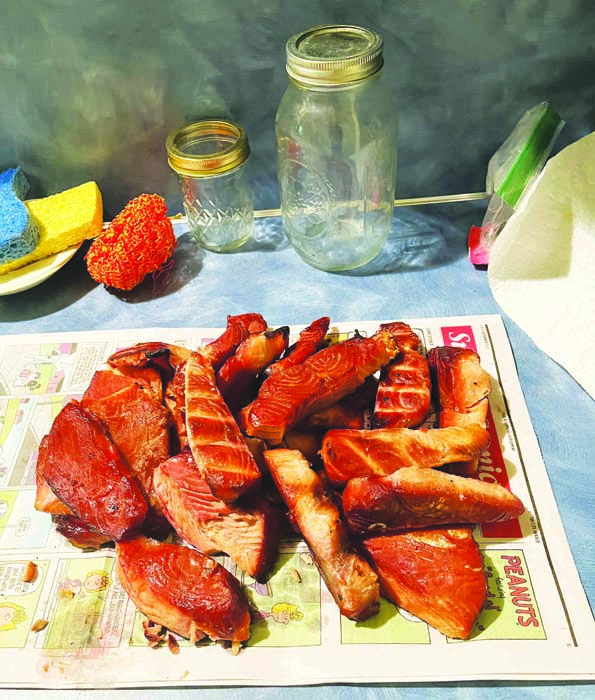The natural world: Smoking out fall chinook from the Hanford Reach
Published 3:00 am Saturday, November 4, 2023

- A pile of smoked fish on the cabin’s kitchen counter is ready to be vacuum-packed and given away for holiday treats.
Stan’s 26-year-old 8-horsepower Honda kicker motor purrs like a contented Siamese cat. It’s the first week in October and we’re back-trolling for fall-run chinook salmon on the Hanford Reach of the Columbia River. Two recent solo trips on my boat yielded nothing for the larder. I’m hoping that teaming up with a proven angler changes my luck.
Trending
“My fishing buddy is done for the year and I’ve got thirty-eight meals in my freezer,” Stan said when he invited me to jump on his boat.
Stars twinkle bright at the launch. A waning harvest moon reminds that salmon season is fast coming to an end. Although the quiet of early dawn soothes my soul, I rarely get up in the dark to fish. However, without a salmon for the smoker, I am eager to test my luck for the early morning bite.
“I usually head up before first light,” Stan shares. “I’ve done it enough times I don’t need to follow a GPS track. My jet boat can operate in a foot of water.”
Trending
Small flocks of mallards lift off from the shallows on the hour-long upriver cruise. Less than a dozen boats work their gear as we pass. A lonesome coyote prowls the cobbled shoreline for a salmon carcass or injured waterfowl. My anticipation grows as the sun rises to impart a golden glow to blooming rabbitbrush.
Arriving near White Bluffs, we put out four rods. I am pleasantly surprised when Stan lends me his lucky “Dill Pickle” Kwikfish.
“It’s caught eight salmon so far this year,” he says.
For my second rod I tie on a chartreuse Spin-n-Glo above a two-hook rig amended with glossy red roe. Stan puts out an egg rod and a battle-scarred Magnum Wiggle Wart. I reflect back to the days before the two-pole option and the challenge of choosing a single setup.
We work a fast run alongside eroded cliffs that appear like the backdrop to a 1950s Western movie with Hopalong Cassidy in the lead role. A nearby boat with three anglers and five rods in play net their one-salmon limits while we watch our rod tips and wait patiently for a take down. “You are making me look bad,” Stan yells when they motor off.
The morning chill is off the water when the tip of my egg rod begins to jerk wildly. Miracles do happen, I think. After two powerful runs, I work a red-sided 22-pound “buck” to the net.
“This one will take care of my smoked salmon needs for the year,” I say to Stan.
“I was starting to doubt,” he replies. I am often reminded that doubt creeps in when it comes to catching small-brain salmon.
Stan loses the next salmon we hook — this one a buck with gun-metal gray flanks — when it dives under the boat. His patience is finally rewarded when a silver-sided, 13-pound hen strikes his lucky Magnum Wiggle Wart at high noon.
“I didn’t believe you when you said there were bright fish to be caught this time of year,” Stan remarks when we put away our gear for the downriver ride.
“Or that you could catch salmon in the middle of the day,” I remind.
Prior to our trip, I emailed Stan a picture of three fall chinook salmon, ranging from 15 to 20 pounds, with the caption, “Fresh-run fish migrate into the Reach in October.” The note was in response to Stan telling me he quit fishing at the end of September because “salmon aren’t fit to eat after that.”
He is mostly correct. So called “upriver bright” fall chinook salmon that arrive early in the season do not retain good flesh quality as they approach their November spawning time. However, salmon that migrate past McNary Dam in early October often have orange-meat flesh worthy of inviting family and friends over for a backyard barbecue.
Historically, the majority of upriver fall chinook salmon production in the Columbia River system occurred in the Snake River. The demographic changed when the three hydroelectric dams that make up the Hells Canyon complex (Hells Canyon, Brownlee and Oxbow) were built from 1959 to 1967, blocking off major upriver spawning areas. The subsequent series of dams built in the mid-Columbia and lower Snake River led to increased use of the Hanford Reach, the only remaining “riverine” habitat. An aggressive hatchery program, in response to the listing of Snake River fall chinook for protection under the Endangered Species Act, has increased run size to the Snake River over the past few decades.
Two weeks later this same October finds me taking care of autumn chores at our cabin. The meat from half of the big salmon fills the top grill of my smoker-cooker. Once the smoked meat cools, I peel off the thick skin and set aside moist chunks of meat for lunch. Our corgi pup sits attentively at my feet for a scrap.
It’s a short walk to the Umatilla River. Woodsmoke from the neighbor’s chimney hangs in the cool air. Quail twitter in the brush. A whitetail deer flicks its flag tail where it feeds on newly fallen apples. Leaves flutter down from nearby alder and cottonwood and settle on the stream margin.
I toss handfuls of the carbonized skin of salmon into a long languid pool. Some pieces sink to the bottom for crayfish and young salmon to nibble on. Other pieces float and disappear from sight where smooth current meets broken water. Perhaps a river otter or racoon will prosper from a mouthful of ocean-derived protein and fat.
As for the hardwood smoked meat of my late-run fall chinook salmon, the brown sugar glaze will surely have friends and relatives begging for more.









